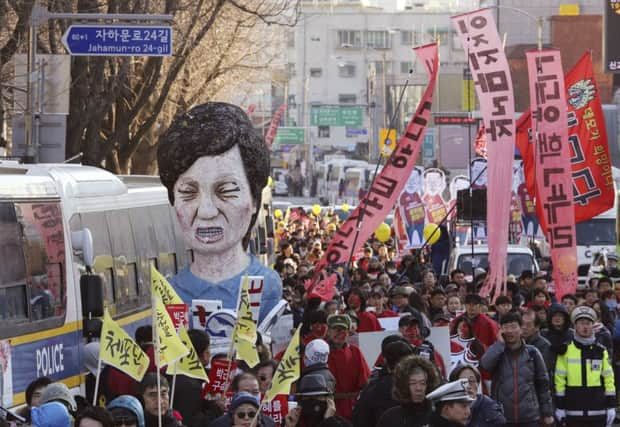Thousands gather to celebrate president's impeachment


The previous time parliament voted to impeach a president, ruling party politicians bawled and hurled ballot boxes, a man set himself on fire and thousands held candlelight vigils night after night in support.
Twelve years after that furore over liberal President Roh Moo-hyun, the mood could not be more different.
Advertisement
Hide AdAdvertisement
Hide AdThe vote for impeachment left protesters basking in pride, believing that they had repaired a damaged democracy with their weekly demonstrations.
Thousands marched close to the presidential palace where the notoriously aloof Ms Park will remain mostly alone for up to six months until the Constitutional Court rules on whether she must step down permanently.
Carrying signs, flags and yellow balloons, they gleefully shouted for her to quit immediately rather than weather the court process.
The demonstrators waved their arms, beat gongs and drums and followed an effigy of Ms Park dressed in prison clothes and tied with rope into an alley near the presidential offices and residence, known as the Blue House.
“Park Geun-hye, get out of the house! Get out of the house now!” the marchers chanted. “Come down and go to jail.”
Seemingly, tens of thousands of demonstrators packed a large nearby boulevard, which was the centre of massive protests in recent weeks.
“We got off to a good first step (on Friday). It was a day when we all realised how strong we can collectively be,” said Kim Hye-in, 51
She lives outside Seoul but is spending her sixth consecutive Saturday there protesting against Ms Park.
Advertisement
Hide AdAdvertisement
Hide AdShe added: “But we aren’t there just yet. We need to keep gathering strength and protest until the court officially removes her from office.”
On Friday, the opposition-controlled parliament passed an impeachment motion against Ms Park, which stripped her of presidential duties.
It pushed Prime Minster Hwang Kyo-ahn into the role of government caretaker until the court rules on Ms Park’s fate.
The impeachment came after millions of people demonstrated for weeks demanding her removal.
State prosecutors accuse Ms Park of colluding with a friend to extort money and favours from South Korea’s biggest companies and give that confidante extraordinary sway over government decisions.
She has apologised for putting trust into her friend, Choi Soon-sil, but has denied any legal wrongdoing.
In 2004, the Constitutional Court reinstated Mr Roh after two months, saying that minor election law violations and accusations of incompetence were not enough to justify his unseating as president.
The chances of the court restoring Ms Park’s powers are considered low because her charges are much graver, although some believe the court will need more than a couple of months to decide as the case is complex.
Advertisement
Hide AdAdvertisement
Hide AdShe will be formally removed from office if at least six of the court’s nine justices support her impeachment, and the country would then hold a presidential election within 60 days.
While the historically large protests that helped push lawmakers to vote to impeach Ms Park have been peaceful, the festive atmosphere kicked up a notch on Saturday as demonstrators let out relief that the president they so desperately want removed was finally halfway out the door.
“We accomplished a peaceful revolution,” said Park Seong-su, a frequent anti-Park protestor.
“For long, people were told by politicians what to do, but on Friday, it was the will of people that forced politicians what to do.”
Others were not as comfortable, saying that protestors should continue to rally every weekend to apply pressure on the court until it decides to formally remove the president.
Kim Hyeong-seok, another protestor, said that the weekly rallies may turn violent if the court decides to reinstate Ms Park. “Then the candles will turn into torches,” he said.
There was tension on Saturday hours before the large demonstration when thousands of Ms Park supporters, most of them in their 60s or older, rallied in nearby streets.
They waved the country’s flags and shouted for her “demagoguery impeachment” to be nullified. Some of them exchanged bitter diatribes with anti-Park protesters.
Advertisement
Hide AdAdvertisement
Hide AdSimilar scenes played out on Friday when scuffles broke out between angry anti-Park farmers, some of whom had driven tractors to the National Assembly, and police.
When impeachment happened, many of those gathered - some 10,000, according to organisers - raised their hands in the air and leapt about, cheering and laughing.
On Saturday, Mr Hwang, as acting president, held a meeting with cabinet ministers to discuss issues related to national security, foreign relations and financial markets.
The handover of power prompted the prime minister on Friday to order South Korea’s defence minister to put the military on a state of heightened readiness to brace for any potential provocation by North Korea.
The impeachment is a remarkable fall for Ms Park, who convincingly beat her liberal opponent in 2012. Her single, five-year term was originally set to end in 2018.
The political turmoil around Ms Park comes after years of frustration over a leadership style that inspired comparisons to her father, slain military dictator Park Chung-hee.
Critics saw an unwillingness to tolerate dissent as her government cracked down on press freedom, pushed to dissolve a leftist party and allowed aggressive police suppression of anti-government protests.
She also was heavily criticised over her government’s handling of a 2014 ferry sinking that killed more than 300 people, mostly school students, and was partially blamed on official incompetence and corruption.